Ecological classification or ecological typology is the classification of land or water into geographical units that represent variation in one or more ecological features. Traditional approaches focus on geology, topography, biogeography, soils, vegetation, climate conditions, living species, habitats, water resources, and sometimes also anthropic factors. Most approaches pursue the cartographical delineation or regionalisation of distinct areas for mapping and planning.
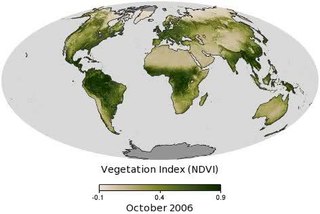
Vegetation is an assemblage of plant species and the ground cover they provide. It is a general term, without specific reference to particular taxa, life forms, structure, spatial extent, or any other specific botanical or geographic characteristics. It is broader than the term flora which refers to species composition. Perhaps the closest synonym is plant community, but vegetation can, and often does, refer to a wider range of spatial scales than that term does, including scales as large as the global. Primeval redwood forests, coastal mangrove stands, sphagnum bogs, desert soil crusts, roadside weed patches, wheat fields, cultivated gardens and lawns; all are encompassed by the term vegetation.
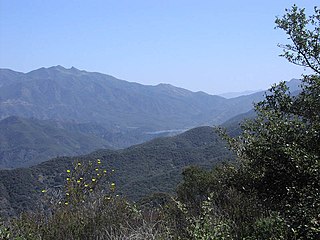
The California chaparral and woodlands is a terrestrial ecoregion of southwestern Oregon, northern, central, and southern California and northwestern Baja California (Mexico), located on the west coast of North America. It is an ecoregion of the Mediterranean forests, woodlands, and scrub biome, and part of the Nearctic realm.

The following is a bibliography of the Sierra Nevada of California, United States, including books on recreation, natural history, and human history.
Frederic Edward Clements was an American plant ecologist and pioneer in the study of plant ecology and vegetation succession.

California coastal prairie, also known as northern coastal grassland, is a grassland plant community of California and Oregon in the temperate grasslands, savannas, and shrublands biome. This ecosystem is found along the Pacific Coast, from as far south as Los Angeles in Southern California to southern Oregon. It typically stretches as far inland as 100 km, and occurs at altitudes of 350 m or lower.
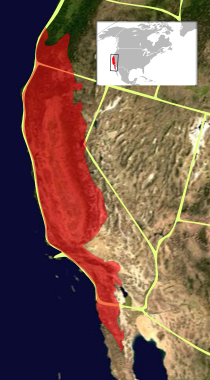
The California Floristic Province (CFP) is a floristic province with a Mediterranean-type climate located on the Pacific Coast of North America with a distinctive flora similar to other regions with a winter rainfall and summer drought climate like the Mediterranean Basin. This biodiversity hotspot is known for being the home of the Sierran giant sequoia tree and its close relative the coast redwood. In 1996, the Province was designated as a biodiversity hotspot allowing it to join ranks among 33 other areas in the world with many endemic species. To be named a biodiversity hotspot, an area has to contain species and plant life that cannot be found anywhere else in the world. The California Floristic Province is home to over 3,000 species of vascular plants, 60% of which are endemic to the province.
Coastal strand is a plant community of flowering plants that form along the shore in loose sand just above the high tide line.
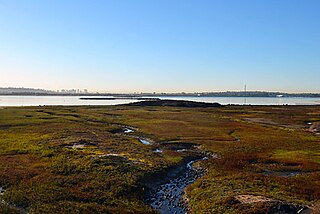
California's coastal salt marsh is a wetland plant community that occurs sporadically along the Pacific Coast from Humboldt Bay to San Diego. This salt marsh type is found in bays, harbors, inlets, and other protected areas subject to tidal flooding.

The Sierra Nevada subalpine zone refers to a biotic zone below treeline in the Sierra Nevada mountain range of California, United States. This subalpine zone is positioned between the upper montane zone at its lower limit, and tree line at its upper limit.

The Sierra Nevada lower montane forest is a plant community along a strip along the western and eastern edges of the Sierra Nevada mountain range in California. This zone is also known as a yellow pine forest.

A plant community is a collection or association of plant species within a designated geographical unit, which forms a relatively uniform patch, distinguishable from neighboring patches of different vegetation types. The components of each plant community are influenced by soil type, topography, climate and human disturbance. In many cases there are several soil types present within a given plant community. This is because the soil type within an area is influenced by two factors, the rate at which water infiltrates or exits the soil, as well as the rate at which organic matter enters or decays from the soil. Plant communities are studied substantially by ecologists, due to providing information on the effects of dispersal, tolerance to environmental conditions, and response to disturbance of a variety of plant species, information valuable to the comprehension of various plant community dynamics.

Juncus phaeocephalus, the brown-headed rush, is native mostly along the coast of California, north to Oregon and Washington. It grows in moist seeps and shallow wet soil.
Sagebrush scrub is a vegetation type (biome) of mid to high elevation Western United States deserts characterized by low growing, drought resistant shrubs including sagebrush and its associates. It is the dominant vegetation type of the Great Basin Desert, occurs along the margins of the Mojave Desert, including in the southern slopes of the Sierra Nevadas and Transverse Ranges of California, and occurs in the Colorado Plateau and Canyonlands region, where it may be referred to as cool desert shrub.
Robert Ornduff (1932–2000) was an American botanist. He was Director of the University and Jepson Herbaria, Director of the University of California Botanical Garden, Executive Director of the Miller Institute for Basic Research in Science, and Chair of the (former) Department of Botany and Professor of Integrative Biology at the University of California at Berkeley. Botanist Phyllis M. Faber said of him following his death, "his extensive knowledge and love of the California flora remains unmatched."
Allan A. Schoenherr was a Californian author, ecologist, and naturalist. He is the author of the widely used reference book, A Natural History of California.
Michael G. Barbour was a Californian botanist and ecologist. He was a Professor Emeritus at the University of California, Davis. His fields of expertise were in autecology and synecology of plants and vegetation in stressful environments, including marine strand, tidal salt marsh, vernal pools, warm desert scrub, mixed evergreen forest, oak forest, and montane conifer forest. This research was conducted in Alta and Baja California along the Pacific coast of North America, on the Gulf of Mexico coast, in northwestern Argentina, in southern Australia, in coastal and arid parts of Israel, in mountains of central-to-northern Spain, in mountains of the Canary Islands, and in mountains of Coast Range and Sierra Nevada of California.
The Sawyer and Keeler-Wolf classification system is an evolving system of classification of vegetation types, plant communities, or floristic characterization. It was first developed in 1995 by John O. Sawyer and Todd Keeler-Wolf for the California Native Plant Society, in the mission to classify all vegetation in California. Particular attention was paid to recognizing rare types that were "lumped" into general categories in previous systems, such as the Munz and Keck classification system, Chetham and Haller classification system, and Holland classification system. It uses constantly updated quantitative measurements of both species diversity and cover to define its types. It intended to be evolving and to continue to be refined.
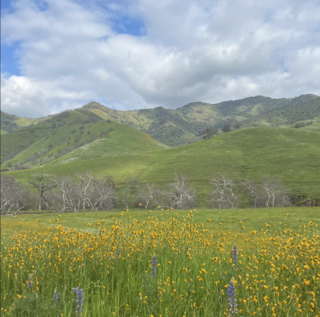
Sycamore Alluvial Woodland is a rare open woodland plant community, or vegetation type, dominated by California sycamore Platanus racemosa, existing only in small parts of California. It exists only in small areas of California in the foothills of the southern Sierra Nevada range and the California Coastal Range. It is rare as a plant community, even though California sycamore is a common component of other vegetation types where it is not dominant. It exists at the base of flat valleys having deep alluvial gravel, where water from the hills hit the flat valley floor having an intermittent stream and large seasonal fluctuations in the water table. It is a habitat type defined by broad-leafed woodland and stable levels of groundwater. Sycamore Alluvial Woodland is identifiable through open savanna riparian structures, with wide floodplains.










